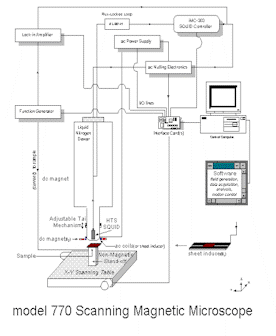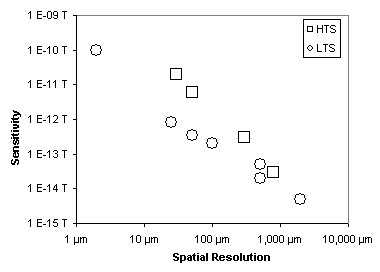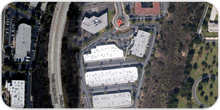Magnetic Microscopes
Tristan Technologies, Inc. has produced a wide range of low frequency magnetic scanning systems: from ultra-high resolution scanning SQUID (LTS) microscopes to HTS systems that apply DC and ac fields; from susceptibility to eddy current measurements to non-contact measurements of electronic circuits. Tristan Technologies can supply magnetic microscopes for your particular needs.

Model SMM-1000 data sheet (download pdf file) High Resolution/Variable Temperature LTS Magnetic Microscope
Model SMM-770 data sheet (download pdf file) HTS Magnetic Microscope (close gap – room temperature samples)
Model SMM-601 data sheet (download pdf file) LTS Medium Resolution /Room Temperature Sample Scanner

Microscope Selection
Key to deciding on the type of instrument to be used is the required sensitivity and spatial resolution. Since these two features tend to be mutually exclusive for a given device, the user needs to decide which requirement is most critical. For example, micron resolution is meaningless if there is not sufficient sensitivity to detect the features being scanned.
The figures of merit used to assess these devices include:
The spacing between magnetic features
This is a key concern. A single dipole can be localized ten times better than resolving two closely spaced dipoles. The smaller and closer the detection coil, the better.
How close one can get to the magnetic feature
Getting much closer than a detection coil diameter gives no significant improvement in spatial resolution, especially for multiple sources.
In essence, the detectable feature size is a product of coil area and stand-off distance.
Tristan offers the following types of scanning magnetic microscopes:
1) Conventional LTS SQUID scanner – see Model SMM-601
2) Scanning LTS SQUID Microscope – see Model SMM-1000
3) Conventional HTS SQUID scanner – see Model SMM-701
4) Scanning HTS SQUID Microscope – see Model SMM-770
Model SMM-601 microSQUID LTS SQUID scanner
This system uses a niobium liquid helium (LTS) SQUID sensor and a separately wound detection coil. It requires the detection coil to be either immersed in liquid helium, or, alternatively, installed in the vacuum space but thermally anchored to a 4.2 K bath. Conventional coils can be wound to < 2 mm diameter. Combined with a 2 mm stand-off, spatial resolutions (for a single dipole) < 250 mm are possible. The ability to use a three-dimensional structure for the detection circuit allows significant external noise rejection. Another advantage of niobium–based superconductors is the ability of the detection coils to operate in Tesla fields. This gives the LTS microscope the ability to make susceptibility measurements on the same spatial resolution scale. In addition, these systems can operate in multi-gauss ac fields with dc – 50 kHz bandwidths for eddy current measurements. The LTS SQUID scanner has the best field sensitivity (< 20 x 10-15 T/√Hz) of any of the microscopes. Scanning areas can be tens of cm in both x and y directions.
Model SMM-1000 Scanning Magnetic Microscope
This system uses a monolithic array of SQUID sensors and LTS coils. Up to nine (linear array) 14 mm x 14 mm coils are at the end of a cantilever that is suspended over the sample. The sample is cooled to allow the detection coils to be within a few mm of the sample, yielding <2 μm spatial resolution. While that accuracy may not be sufficient to locate a specific submicron transistor, it can place defects in the vicinity so other tests can be performed. The use of superconducting stepper motors allow 0.16 mm X-Y resolution on the scanning stage when covering a 5 mm x 5 mm scan area. Since the sample and coils are both cooled, superconducting shielding can be used to eliminate all external noise sources. Changing samples requires the cryostat to be warmed and recooled. It is also possible to add field generation coils to apply small DC and ac fields, useful for susceptibility and eddy current measurements.
The LTS Scanning Magnetic Microscope has a field sensitivity < 100 x 10-12 T/√Hz. A relatively mature technology, it has a low risk factor in terms of technology development. One such system has been operating for nearly thirty years.
Model SMM-701 HTS SQUID Scanning System
The high temperature (HTS) version of the microSQUID uses a YBCO HTS SQUID sensor that operates at ~77 K, the boiling point of liquid nitrogen. The inherent anisotropic nature of the HTS superconductors requires that the planar detection coil be integral or inductively coupled to the sensor, unlike the LTS microSQUID which uses 3-dimensional gradiometer coils for improved noise rejection. Commercially available HTS sensors have typically consisted of a single turn coil with a 3 or 10 mm hole, and typical sensitivities <500 x 10-15 T/√Hz. Decreasing the HTS coil size can improve spatial resolution, but at a decrease in sensitivity (see below). Sensors can be made with 2 mm standoff distances; the use of sapphire windows allow 50 mm and smaller stand-off distances.
Unlike LTS SQUIDs, HTS SQUIDs do not have the ability to operate in tesla fields. It is however possible to operate a HTS microscope in up to 0.1 tesla fields. HTS systems have been operated in milligauss ac fields with dc – 20 kHz bandwidths. This makes them the preferred (HTS) device for susceptibility and eddy current measurements on macroscopic samples. Like the LTS microSQUID, scanning areas can be tens of cm in both x and y directions.
Model SMM-770 HTS SQUID Microscope
This system uses a HTS squid with a detection coil having a 40 mm hole. With the sample mounted in the dewar vacuum space but thermally anchored to the liquid nitrogen bath or closed cycle refrigerator, stand-off distances < 100 μm between detection coil and measurement sample are possible. The SMM-770 has a sensitivity ~ 10-11 T/√Hz. Scanning areas can be up to 15 cm x 15 cm.
Unfortunately, its magnetometer detection coil configuration makes the SMM-770 susceptible to external noise sources. Operation in a shielded environment improves noise immunity. By using phase sensitive detection (injecting an ac current into the device under test), background noise can be filtered out. The addition of external field coils makes susceptibility measurements (DC or ac) possible.
One attractive use for the SMM-770 system is the measurement of circuit board current traces. By overlaying system images on a CAD map of an IC or circuit board features, it is possible to locate where actual faults occur. Under ideal conditions, a SQUID can detect as little as 10 nA flowing in a conductor that is 100 µm from the sensor.
Which to Choose?
 The choice of microscope system depends on the needed spatial resolution and magnetic field sensitivity. Resolution (the minimum separation between two magnetic features) is dependent on both the distance from the sensor to the sample (stand-off) and the detection coil size. If a SQUID microscope can place its sensor very close to the sample (< 2 coil diameters), then the coil size is the limiting factor to resolution.
The choice of microscope system depends on the needed spatial resolution and magnetic field sensitivity. Resolution (the minimum separation between two magnetic features) is dependent on both the distance from the sensor to the sample (stand-off) and the detection coil size. If a SQUID microscope can place its sensor very close to the sample (< 2 coil diameters), then the coil size is the limiting factor to resolution.
Because the flux sensitivity of SQUID sensors is roughly constant, there is an inverse relationship between sensitivity and spatial resolution. The figure below shows the trade off between sensitivity and spatial resolution for a number of different SQUID based systems.
Sensitivity and Spatial Resolution of a number of SQUID microscopes
The Table below shows the capabilities of a number of Tristan magnetic microscopes.
|
System |
Spatial Resolution |
Sensitivity |
Scan Area |
Step Size |
|
1000 |
2 µm |
100 pT/√Hz |
5 mm x 5 mm |
0.2 µm |
|
770 |
<100 µm |
20 pT/√Hz |
15 cm x 15 cm |
25 µm |
|
601 |
2 mm |
5 fT/√Hz |
30 cm x 30 cm |
25 µm |
|
601S |
0.5 mm |
50 fT/√Hz |
30 cm x 30cm |
25 µm |
|
660 |
0.5 mm |
20 fT/√Hz |
Use robot arm |
25 µm |
|
701 |
1 mm |
30 fT/√Hz |
30 cm x 30 cm |
25 µm |
Custom versions can be supplied to achieve larger scan areas, smaller step sizes, etc. Contact Tristan Technologies for additional information.


